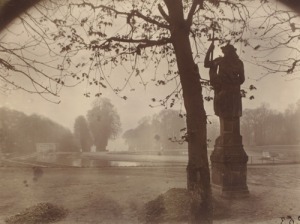Misty mornings in parks, the shape of statues echoing that of nearby trees; long cobbled streets that invite the eye to wander down them; mannequins in shop windows that appear oddly animate. These are some of the 10,000 images that Eugène Atget (1857-1927) took of Paris in the first quarter of the 20th century, which are both visual documents of the city and carriers of a poetic sense of place. Atget’s photography was a quiet, personal obsession – this was long before the advent of the ‘photo-essay’ in contemporary art, in which a subject or world is photographed multiply and explored in depth. Atget didn’t even consider his work as art although his work was lauded by the Parisian avant-garde, by Man Ray who saw in his work a latent surrealist sensibility, an unexpected evocation of the unconscious life of the city; by Andre Breton who published him in Le Revolution Surrealiste and in his own books.
Atget used old photographic equipment with very long exposures so his photographs are often devoid of people. This allows the form of the city to be clearly seen, its architecture and arched bridges, its sweep of streets and stairwells. Yet the empty city still bears a palpable, if mysterious, presence of real lives lived and so invites narratives, stirs the viewer to imagine. Atget’s images also appeal through their nostalgia. They were memory traces of a vanishing world – he worked in the old parts of Paris being bulldozed to make way for wide modern boulevards. John Szarkowski, former director of photography at MOMA in New York, believed that the way Atget blended documentation and a distinct personal vision made him the first real modernist photographer: “The pictures that he made…are seductively and deceptively simple, wholly poised, reticent, dense with experience, mysterious, and true” (from Szarkowski’s Looking at Photographs).




